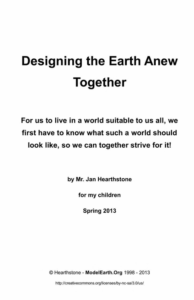Read free. A Pattern Language: Towns, Buildings, Construction, by Christopher Alexander, et al., 1977.
- View/download the PDF. This is a very big book and may take a while to load.
- Read online or download in more formats.
Excerpt
From “How to Use This Book”:
Volume 1, The Timeless Way of Building, and Volume 2, A Pattern Language, are two halves of a single work. This book provides a language, for building and planning; the other book provides the theory and instructions for the use of the language. This book describes the detailed patterns for towns and neighborhoods, houses, gardens, and rooms. The other book explains the discipline which makes it possible to use these patterns to create a building or a town. This book is the sourcebook of the timeless way; the other is its practice and its origin.
The two books have evolved very much in parallel. They have been growing over the last eight years, as we have worked on the one hand to understand the nature of the building process, and on the other hand to construct an actual, possible pattern language. We have been forced by practical considerations, to publish these two books under separate covers; but in fact, they form an indivisible whole. It is possible to read them separately. But to gain the insight which we have tried to
communicate in them, it is essential that you read them both.The Timeless Way of Building describes the fundamental nature of the task of making towns and buildings. It is shown there, that towns and buildings will not be able to become alive, unless they are made by all the people in society, and unless these people share a common pattern language, within which to make these buildings, and unless this common pattern language is alive itself.
In this book, we present one possible pattern language, of the kind called for in The Timeless Way. This language is extremely practical. It is a language that we have distilled from our own building and planning efforts over the last eight years. You can use it to work with your neighbors, to improve your town and neighborhood. You can use it to design a house for yourself, with your family; or to work with other people to design an office or a workshop or a public building like a school. And you can use it to guide you in the actual process of construction.
The elements of this language are entities called patterns. Each pattern describes a problem which occurs over and over again in our environment, and then describes the core of the solution to that problem, in such a way that you can use this solution a million times over, without ever doing it the same way twice.
Introductory Pages
AI Summary
A Pattern Language is a groundbreaking architectural book that introduces a design methodology built around “patterns” — timeless, repeatable solutions to recurring problems in the built environment. It provides a practical guide to creating human-centered towns, buildings, and homes that support well-being, beauty, and community.
What is a Pattern Language?
A “pattern” describes a design problem and a proven solution that enhances life. The book contains 253 patterns arranged from the most macro (regions and towns) to the most micro (doorways and ornament). Patterns are meant to be used in combination, like words in a language, to form a coherent, life-supporting design.
Core Philosophy
- Design for People: Spaces should reflect human needs and encourage community, interaction, and comfort.
- Organic Order: Built environments must evolve through the participation of those who live in them, not just top-down planning.
- Wholeness and Harmony: Good design promotes balance between parts and the whole — cities, buildings, and rooms that feel “alive.”
Structure of the Book
The 253 patterns are grouped into three general levels:
- Patterns for Towns: Address regional planning, transportation, and public space (e.g., Pattern 1: Independent Regions, Pattern 30: Activity Nodes).
- Patterns for Buildings: Cover the design of groups of buildings and individual buildings (e.g., Pattern 105: South Facing Outdoors, Pattern 112: Entrance Transition).
- Patterns for Construction: Tackle construction details, spatial elements, and interiors (e.g., Pattern 179: Alcoves, Pattern 197: Thick Walls).
How to Use the Book
Each pattern has a title, problem statement, discussion, and solution. Readers are encouraged to flip through and select patterns that resonate with their design goals, combining them into a “language” specific to their context — whether for building a house, designing a neighborhood, or planning an entire town.
Why It Matters
This book empowers individuals and communities to reclaim the act of design. Instead of relying solely on professionals, *A Pattern Language* encourages participatory creation of environments that feel intuitive, nurturing, and deeply connected to human life.
Legacy
*A Pattern Language* has influenced architecture, urban design, software development (notably design patterns in programming), and participatory planning. Its impact lies in its clarity, human-centeredness, and invitation to co-create places worth living in.
Related Posts

Sustainable Communities

Maker Projects for Kids Who Love…

Environmental Design Science Primer



